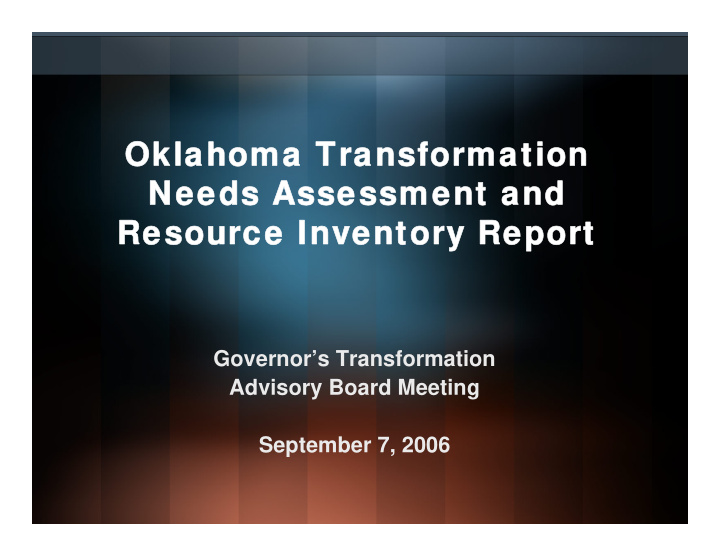



Oklahoma Transformation Oklahoma Transformation Needs Assessment and Needs Assessment and Resource Inventory Report Resource Inventory Report Governor’s Transformation Advisory Board Meeting September 7, 2006
Report Development Process Report Development Process January – May: Collect and analyze key recent reports on mental health and substance abuse February – June: Interview over 1,000 persons through focus groups and key interviews May – July: Analyze notes from interviews April – August: Analyze data from ODMHSAS, OHCA and other state agency files July – August: Draft report August: Feedback received from GTAB Needs Assessment subcommittee and state agencies on draft report September: Revised report published for public comment
Purposes of the Report Purposes of the Report • To provide a justification of the need for change, in language that is accessible to all audiences • To present the findings in a way that emphasizes the overarching goals and values of the President’s New Freedom Commission Report to inform the direction of change • To recognize the strengths of current programs • To lay the foundation for the evaluation of change
Invited Comments Invited Comments • Did we do what we set out to do? • What is incorrect? • What did we miss? • What did we place too little emphasis on? • What did we do well?
Next Steps Next Steps • September 7 : Presentation to GTAB • Through September 15 – Continue to receive public comments • September 18-21 – Analyze comments received from the GTAB, state agencies, and the public, and • September 22 – Submit Initial Needs Assessment Report to the Center for Mental Health Services (USDHHS)
Key Findings Key Findings • Areas of excellence in the Oklahoma mental health and substance abuse system • Many challenges to extend the strengths of the system to all Oklahoma communities
Areas of Excellence Areas of Excellence • System of care programs developed • Recent developments for systems to be more recovery focused • Child welfare focus on kinship adoption • Program of Assertive Community Treatment developed • Tulsa Mental Health Association housing development
Areas of Excellence Cont’d Areas of Excellence Cont’d • Law enforcement crisis intervention training • Jail Diversion programs, including Mental Health and Drug Courts • Special MH and SA programs at Joseph Harp and Mabel Bassett • Reentry Project in Oklahoma City for persons released from prison with history of serious mental illness
Challenges Challenges System of care programs developed • Systems of Care has rapidly expanded but more expansion is still needed. • Many children must be served in residential facilities because of the lack of community-based care
Challenges Challenges Program of Assertive Community Treatment development • PACT programs are needed in additional communities Tulsa Mental Health Association housing development • Need for increased access to housing elsewhere in the state
Challenges Challenges Law enforcement crisis intervention training • Law enforcement in many localities have only one hour per year in training related to mental health or substance abuse Jail Diversion programs, including Mental Health and Drug Courts • Jail diversion programs serve only a fraction of the persons who can be diverted into alternative programs and jails have limited resources for persons with substance abuse and mental health problems—although they constitute a large proportion of the population
Challenges Special MH and SA programs at Joseph Harp and Mabel Bassett • There is a need for additional treatment services for mental health and substance abuse for people in prison Reentry Project in Oklahoma City for persons released from prison with history of serious mental illness • Many people with serious mental illness are released into the community with no supervision and no effective linkage to mental health programs
Challenges Challenges • There is a very large gap between persons receiving treatment and the estimates of the prevalence of mental illness and substance abuse among both adults and children • There are inequities in access to most mental health and substance abuse services between Oklahoma counties (especially rural areas)
Challenges Challenges Workforce • High turnover • Often overwhelmed by paperwork • Gaps in training • Gaps in experienced, qualified professionals, e.g., child psychiatrists
From Needs A From Needs Assessment to ssessment to Planning & Evaluation Planning & Evaluation • To inform the direction of change – The comprehensive plan is intended to provide a path for responding to these challenges. • To lay the foundation for the evaluation of change – Beginning in October, we will begin the process of evaluating how far Oklahoma is able to go in addressing these challenges.
Recommend
More recommend